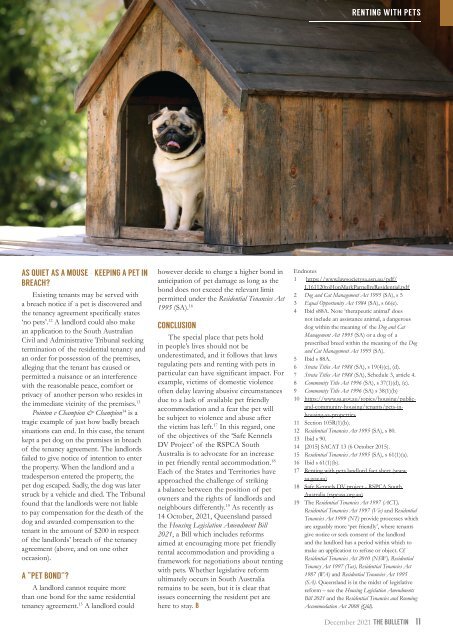LSB December 2021 HR
Create successful ePaper yourself
Turn your PDF publications into a flip-book with our unique Google optimized e-Paper software.
RENTING WITH PETS<br />
AS QUIET AS A MOUSE - KEEPING A PET IN<br />
BREACH?<br />
Existing tenants may be served with<br />
a breach notice if a pet is discovered and<br />
the tenancy agreement specifically states<br />
‘no pets’. 12 A landlord could also make<br />
an application to the South Australian<br />
Civil and Administrative Tribunal seeking<br />
termination of the residential tenancy and<br />
an order for possession of the premises,<br />
alleging that the tenant has caused or<br />
permitted a nuisance or an interference<br />
with the reasonable peace, comfort or<br />
privacy of another person who resides in<br />
the immediate vicinity of the premises. 13<br />
Pointon v Champion & Champion 14 is a<br />
tragic example of just how badly breach<br />
situations can end. In this case, the tenant<br />
kept a pet dog on the premises in breach<br />
of the tenancy agreement. The landlords<br />
failed to give notice of intention to enter<br />
the property. When the landlord and a<br />
tradesperson entered the property, the<br />
pet dog escaped. Sadly, the dog was later<br />
struck by a vehicle and died. The Tribunal<br />
found that the landlords were not liable<br />
to pay compensation for the death of the<br />
dog and awarded compensation to the<br />
tenant in the amount of $200 in respect<br />
of the landlords’ breach of the tenancy<br />
agreement (above, and on one other<br />
occasion).<br />
A “PET BOND”?<br />
A landlord cannot require more<br />
than one bond for the same residential<br />
tenancy agreement. 15 A landlord could<br />
however decide to charge a higher bond in<br />
anticipation of pet damage as long as the<br />
bond does not exceed the relevant limit<br />
permitted under the Residential Tenancies Act<br />
1995 (SA). 16<br />
CONCLUSION<br />
The special place that pets hold<br />
in people’s lives should not be<br />
underestimated, and it follows that laws<br />
regulating pets and renting with pets in<br />
particular can have significant impact. For<br />
example, victims of domestic violence<br />
often delay leaving abusive circumstances<br />
due to a lack of available pet friendly<br />
accommodation and a fear the pet will<br />
be subject to violence and abuse after<br />
the victim has left. 17 In this regard, one<br />
of the objectives of the ‘Safe Kennels<br />
DV Project’ of the RSPCA South<br />
Australia is to advocate for an increase<br />
in pet friendly rental accommodation. 18<br />
Each of the States and Territories have<br />
approached the challenge of striking<br />
a balance between the position of pet<br />
owners and the rights of landlords and<br />
neighbours differently. 19 As recently as<br />
14 October, <strong>2021</strong>, Queensland passed<br />
the Housing Legislation Amendment Bill<br />
<strong>2021</strong>, a Bill which includes reforms<br />
aimed at encouraging more pet friendly<br />
rental accommodation and providing a<br />
framework for negotiations about renting<br />
with pets. Whether legislative reform<br />
ultimately occurs in South Australia<br />
remains to be seen, but it is clear that<br />
issues concerning the resident pet are<br />
here to stay. B<br />
Endnotes<br />
1 https://www.lawsocietysa.asn.au/pdf/<br />
L161120toHonMarkParnellreResidential.pdf<br />
2 Dog and Cat Management Act 1995 (SA), s 5<br />
3 Equal Opportunity Act 1984 (SA), s 66(e).<br />
4 Ibid s88A. Note ‘therapeutic animal’ does<br />
not include an assistance animal, a dangerous<br />
dog within the meaning of the Dog and Cat<br />
Management Act 1995 (SA) or a dog of a<br />
prescribed breed within the meaning of the Dog<br />
and Cat Management Act 1995 (SA).<br />
5 Ibid s 88A.<br />
6 Strata Titles Act 1988 (SA), s 19(4)(c), (d).<br />
7 Strata Titles Act 1988 (SA), Schedule 3, article 4.<br />
8 Community Title Act 1996 (SA), s 37(1)(d), (e).<br />
9 Community Title Act 1996 (SA) s 38(1)(b)<br />
10 https://www.sa.gov.au/topics/housing/publicand-community-housing/tenants/pets-inhousing-sa-properties<br />
11 Section 105R(1)(b).<br />
12 Residential Tenancies Act 1995 (SA), s 80.<br />
13 Ibid s 90.<br />
14 [2015] SACAT 13 (6 October 2015).<br />
15 Residential Tenancies Act 1995 (SA), s 61(1)(a).<br />
16 Ibid s 61(1)(b).<br />
17 Renting with pets landlord fact sheet (www.<br />
sa.gov.au)<br />
18 Safe Kennels DV project - RSPCA South<br />
Australia (rspcasa.org.au)<br />
19 The Residential Tenancies Act 1997 (ACT),<br />
Residential Tenancies Act 1997 (Vic) and Residential<br />
Tenancies Act 1999 (NT) provide processes which<br />
are arguably more ‘pet friendly’, where tenants<br />
give notice or seek consent of the landlord<br />
and the landlord has a period within which to<br />
make an application to refuse or object. Cf<br />
Residential Tenancies Act 2010 (NSW), Residential<br />
Tenancy Act 1997 (Tas), Residential Tenancies Act<br />
1987 (WA) and Residential Tenancies Act 1995<br />
(SA). Queensland is in the midst of legislative<br />
reform – see the Housing Legislation Amendments<br />
Bill <strong>2021</strong> and the Residential Tenancies and Rooming<br />
Accommodation Act 2008 (Qld).<br />
<strong>December</strong> <strong>2021</strong> THE BULLETIN 11


















